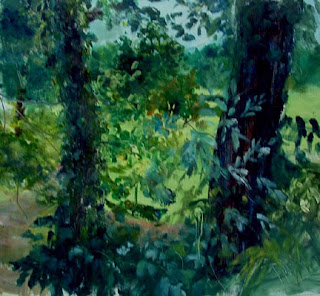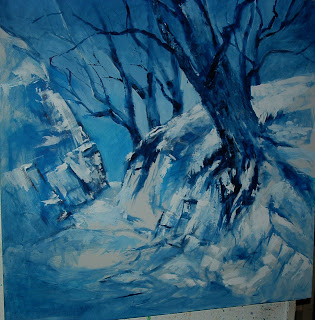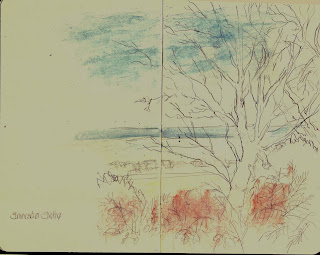trees and 'sky holes'
I was asked about how I paint/draw trees and deal with the 'sky holes' - it was asked in the comments section and it related to an older post - and I can't find it! so apologies if I'm not answering the question right!

all images are copyright
The answer isn't simple because it depends on what medium I'm using.
This one was done plein air, in oils, over a couple of hours maximum. So wet in wet paint. The sky was painted back in between the leaves and branches as in the studio painting below.
Oil paint is the simplest, because I can work backwards and forwards. I will probably roughly sketch in the branches and/or foliage but then I'll go back in with the sky colour, sometimes while the paint is wet, to get soft blurred edges and sometimes later when it's dry to keep the colour clean. It give more organic, less hard edged shapes to the branches and twigs and enables me to get finer lines for the highest twigs and have lost and found parts, the way that the eye sees the tree - we don't see it clearly defined as in a photograph.
This was stage one of the 40 inch square canvas, started in acrylic paints in the underpainting, sorting out where things were going. A lot of the snow and ice remains in the final version but the trees and sky were worked on a lot in oils, pushing the further trees into the distance and creating a depth to the pattern of twigs and branches.


Here a section of twigs and branches is finished - worked and reworked in layers, painting branches, overpainting patches of sky, scratching through to get twiggy thin marks - always working backwards and forwards towards the effect I'm after.
I like acrylic for the underpainting for speed of drying and because when I scratch through oil paint to the underlying acrylic it scratches to a clear clean colour. Scumbling oil paint also allows the underlying acrylic paint to show through. I don't like working in acrylic for the whole painting though. I like the feel and handling of oil paint in the later stages. The work may look textured, and is, but I don't use terrifically thick globs of paint, I use a knife but it's about applying the paint and making the kind of loose marks I want rather than applying quantity. Some washy bits are actually very thin paint and some of the knife marks are scraped on very thinly.
If I'm sketching or using watercolours then I do need to establish where the sky will show through. I never put a wash of sky down and then fit the trees on top. I need to know where the sky holes will be and then fit the sky in and the leaves/branches around them. Putting branches and leaves down on top of a wash can give a cut and pasted look.
This was an experiment to see just how badly watercolours behaved in a normal moleskine - the answer was VERY badly! they beaded and sat on the surface and had to be scrubbed in with a finger - so I finished the sketch with coloured pencil over scrubbed in watercolour. Here's the drawing and disastrous watercolour!

The branches of the tree were light against a darker background so I needed to establish where they were and fit the background around them. The twiggy bits were darker so they could be put down on top of the sky where necessary.

When I sketched down by the canal in charcoal I could work backwards and forwards again - the leaves of the tree were light against a dark brick wall - the leaves and branches were 'drawn' with an eraser, lifting the charcoal. Then I could go back in and darken the wall in the spaces.
I really like media that allow me to work this way, pushing and pulling the lights and darks and colours until it's a close as I can get it to how I want.

and with watercolour I let the distant trees and sky blur.

I hope all this makes sense and helps :)



Comments
You probably did answer something just like this earlier. I was still thinking more along the lines of drawing rather than painting. I am finding painting requires a much different way of thinking. So your information probably zoomed over my head.
Few more questions? Are you using black or mixing your darks from complements. Its hard to tell in the winter scape.And are you using a flat brush or rounds or both?
Again, many thanks for such an in depth,multi media answer.
it's the lovely thing with oils that you can work back and forth and change things, have things just showing through a little etc :) It's why I prefer oils to acrylics.
I'm going to carry on with the answer in the blog so it follows on from the last stuff :)